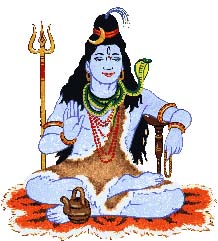|
Festivals of India
Mahashivaratri
|
|||||
Shiva is also known as Nataraja or Nateswara (Lord of dance). Shiva is characterised by an angry temperament and we are told, he has a third eye on his forehead that emits fire if opened. The unfortunate Madana who dared disturb Shiva's meditation was reduced to ashes when Shiva opened his third eye, enraged by Madana's having disturbed his Tapasya (meditation). |
Festivals Of India • Festival Calendar • Ganesh Chaturthi • Nagpanchmi • Ramanavami • Janmastami • Diwali • Passage to India • Features • Tips | ||||
Shankara = Shankha Kara ?
We see that Shiva is clothed in animal skins, he carries a three pointed spear (trishul), is dark in complexion and wears snakes on his body. All these speak of a hunter's lifestvle. A conch (shankha) is blown to invoke Shiva, this is not so in the case of other Hindu deities. The conch is a rather primitive instrument used in tribal societies. There is a special relation between the conch (shankha) and Shiva as is evident from the similarity between the word Shankha and the word Shankara which is one of Shiva's many names. The word Shankara could have been derived from Shankha-kara which roughly means conch-blower (Shankha = conch, Kara = blower).
Shiva a Pre-Aryan Tribal Deity ?
Shiva and Worship of the Phallus Thus the festival of Mahashivaratri is dedicated to a deity whose origins are lost in the hoary past. But the practices that are associated with Mahashivaratri are eloquent in themselves. Apart from the fast observed on that day and the special prayers that are offered to the Lord of Kailas - the destroyer - the essential ritual is of fermenting bhang an intoxicating beverage. Only when devotees intoxicated with bhang dance themselves to a feverish pitch is Mahashivaratri considered to have been celebrated in it's true 'spirit'. Shiva is a Prototype of a Hunter's Deity.
|
|||||
Editor: Romola Butalia (c) India Travelogue. All rights reserved. |
|||||
 Again the fine nuances observed in other Hindu deities especiallv Vishnu are missing in Shiva. Shiva is never shown wearing a dhoti (a loin-cloth draped around the waist) which is invariably worn by all other Gods. Nor does Shiva wear a Kaya-bandha (a metallic belt around the waist) as is worn by all other Gods. Shiva also has no jewellery that other Gods have. This along with his dark complexion suggests that Shiva originates in a pre-Aryan environment. His dark complexion and other characteristics, though explained away with the story of Samudra-manthan (the battle between Gods and demons) in which the Gods lose and as a result one of them has to drink Halaahala (poison). Shiva is chosen to do this and this results in his dark complexion. For this he is also called Neel-kantha (Blue-necked), the poison having turned his neck blue. Mythology says that to overcome the burning sensation caused by the poison, Shiva sports the cool snakes around his neck and has the Ganga river flow around his neck.
Again the fine nuances observed in other Hindu deities especiallv Vishnu are missing in Shiva. Shiva is never shown wearing a dhoti (a loin-cloth draped around the waist) which is invariably worn by all other Gods. Nor does Shiva wear a Kaya-bandha (a metallic belt around the waist) as is worn by all other Gods. Shiva also has no jewellery that other Gods have. This along with his dark complexion suggests that Shiva originates in a pre-Aryan environment. His dark complexion and other characteristics, though explained away with the story of Samudra-manthan (the battle between Gods and demons) in which the Gods lose and as a result one of them has to drink Halaahala (poison). Shiva is chosen to do this and this results in his dark complexion. For this he is also called Neel-kantha (Blue-necked), the poison having turned his neck blue. Mythology says that to overcome the burning sensation caused by the poison, Shiva sports the cool snakes around his neck and has the Ganga river flow around his neck.
